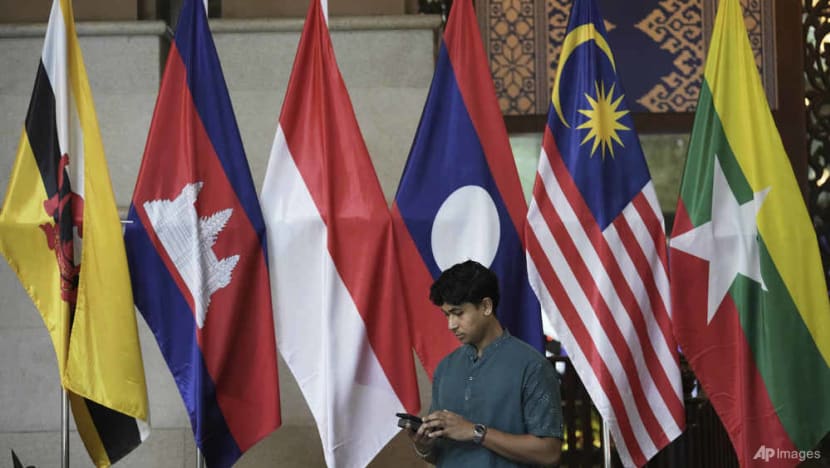Commentary: In US-China rivalry, Southeast Asia is no one’s prize. Why do we insist otherwise?
We need to stop rehashing trite arguments about the self-interested gaze of great powers near and far, says this academic.

A hotel staff stand in front of ASEAN flags, waiting for delegates to arrive at a hotel in Kuala Lumpur, Malaysia, on Apr 9, 2025. (AP Photo/Vincent Thian)
WASHINGTON, DC: It’s 2025, yet we’re still talking about Southeast Asian countries as outposts – spheres of influence, in wonk speak – for imperial influence.
Ten years since the great power competition framework returned to Washington, tentatively at first under Barack Obama’s second administration then with a vengeance under Donald Trump’s initial reign, Southeast Asia is still being subjected to speculation on whether, when, and how countries will tilt towards China or the United States.
It is a lazy, tired trope, repeated inside the region as well as beyond, that refuses to disappear despite pleas and exhortations by government leaders for greater nuance in explaining the foreign policy conduct of smaller states.
Treating the region as a “prize” denies textured realities where individual countries or the region collectively can appear to favour one power on a particular issue at a specific time but still enjoy solid ties with another in different though sometimes related areas.
For example, China has been Malaysia’s largest trading partner for 16 consecutive years. But the United States has also consistently placed among the top three of Malaysia’s largest foreign direct investment (FDI) sources. Additionally, Malaysia’s defence and security ties with the United States – a “well-kept secret” – can be traced back to the Vietnamese theatre of the Cold War, compared to Malaysia’s defence links with China, which only took off in the early 1990s.
The Association of Southeast Asian Nations (ASEAN) and China are each other’s largest trading partners, but the United States was ASEAN’s top foreign direct investment source in 2023 (it narrowly came in second to intra-ASEAN FDI in 2022).
XI JINPING’S SOUTHEAST ASIA TOUR
There are countless other examples of the region managing different facets of its relationship with the two behemoths and in the case of the United States, its allies as well. That no relationship can be simplified to a dichotomy should be blindingly obvious.
However, China’s President Xi Jinping’s trip last week to Vietnam, Malaysia, and Cambodia provides the latest fodder for conjecture about whether these three countries will be tempted to drift further into Beijing’s orbit.
Xi’s tour happened just two weeks after US President Donald Trump unleashed tariffs on the world, hitting Southeast Asian countries including Cambodia (49 per cent) and Vietnam (46 per cent) among the hardest. Yet Xi’s trip wasn’t in response to the tariffs but had been planned for weeks if not months in advance.
The serendipity of the trip’s timing was inescapable. Xi signed approximately 40 deals in each country, just as the region was roiling from Washington’s punitive trade measures.
This inevitably framed the visits as a study in contrasts: China as a steady, reliable partner and the United States, a haughty, capricious one. Trump’s boast of countries begging for a deal – “kissing my ass” – only cements the image of a United States disdainful of the rest of the world.
The argument that Trump's executive fiat, whether in the form of unilateral tariffs or the termination of foreign policy assistance, will only cede diplomatic space to Beijing is one that appeals most among some in Washington.
But the subtext is clear, regardless of the audience. It presumes that Southeast Asia is to be won or lost, and that if any power is to envelop the region in its protective embrace, it should be the United States. Why? (In case unclear, this question is rhetorical.)
BUILD ON REGION’S POTENTIAL
Beijing pointedly reminded the region – at an ASEAN-led meeting, no less – that “China is a big country and other countries are small countries, and that’s just a fact”. South China Sea claimants also know all too well what a territorially aggressive China is capable of.
Beijing’s most recent warning against any deals between the United States and other countries “at the expense of Chinese interests” places Southeast Asia on notice given the region’s importance in the global technological value chain.
Yet Trump has also made it explicit that Washington will return to its imperial instincts, declaring in his second inaugural address that “the United States will once again consider itself a growing nation – one that increases our wealth, expands our territory, builds our cities, raises our expectations, and carries our flag into new and beautiful horizons”.
Trump’s America First policy is simply an unfiltered version of the long-standing utilitarian US approach to Southeast Asia that has undergone different iterations in past decades: From the ideological clash of the Cold War that rived mainland Southeast Asia to the all-consuming Global War on Terror that labelled much of maritime Southeast Asia as the “second front” of Washington’s campaign.
The region’s significance is again in focus as Beijing and Washington slug it out in the race for technological supremacy.
Southeast Asia has certainly benefited from competitive major power statecraft on the diplomatic, economic, and socio-cultural fronts. But the region’s population would be better served in the 21st century by policy elites building Southeast Asia’s collective potential in new and creative ways, rather than rehashing trite arguments about why the region matters for the self-interested gaze of metropoles near and far.
After all, if the world is to be reordered, so too should its narratives.
Elina Noor is a senior fellow in the Asia Program at the Carnegie Endowment for International Peace in Washington, DC. This commentary first appeared on Lowy Institute’s blog, The Interpreter.















